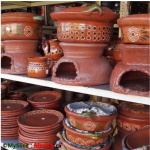
Black History Month takes place during February in several countries, including Canada; it originated in the United States, where it is also known as African-American History Month. It is not officially recognized in Mexico, but the African influence in Mexican History is incredibly vast and important, considered as “the third root” of national and racial heritage, after Native and European roots.
In my previous post, I shared a recipe for Yucatan Style Black Beans and Pork – frijol con puerco, served with rice, as pictured above. I concluded with a teaser about the disputed possible origin of the dish, which some historians believe is definitely from African slaves, who cooked their traditional beans and rice, later adding discarded pieces of meat and bones, while other scholars have refuted this theory, because Europeans are known to use all parts of the pig (“everything but the squeal” as they say in Spain), hence slaves would not have had access to any meat for their food, at all. In regards to a similar dish called feijoada – a beans and meat preparation, traditional in Portugal and its former colonies, including Brazil, where it is considered the national dish – it has been established that, since meat and legume stews existed in Europe since Ancient Rome times, it is more likely that in the colonies, native beans were easily adopted in this type of dishes, cooked as in the original European tradition, with meat, by the upper classes, and with substitutions of rice, roots, and vegetables, by African slaves, and the poor. This brings up the questions of whether Yucatan’s frijol con puerco has a similar past as feijoada, within the European and criollo (Spanish descendants) upper classes, and how strong any African influence could have been.
As in many other instances in Mexican history, the participation of African nationals and their descendants during colonial times in the Yucatan peninsula was dismissed and often forgotten; because the capital city of Merida was founded on the ruins of a large Mayan community, there was an abundance of enslaved native force to work the fields and mines, and for many years, the portrait of a simple society of European, Mayan and mestizo (mixed Spanish and indigenous) populations prevailed. This image had to be modified because there are records of two churches were Africans and their descendants worshiped; however, the neighbourhoods were labelled as “black”, implying that although present, African people (enslaved or free), would have been concentrated and isolated in particular boroughs of the city, away from the downtown area, where the upper class resided. Population registries show that by the early 1700s, African descendants and castes (as mixed African/Spanish/Mayan were called) represented about 13 percent in the peninsula, maybe small in absolute terms, but only slightly smaller than the total Spanish, criollo and mestizo population, with Mayas adding up to around 66 percent.
In 2009, Matthew Restall, a Colonial Latin American History professor at Penn State University who specializes in the Maya in Mexico, Guatemala and Belize, and Africans in Spanish America, published the book “The Black Middle: Africans, Maya, and Spaniards in Colonial Yucatan”, in which he affirms that Afro-Yucatecans played middle positions in the colony, serving as a junction of social positions, somewhere in between the ruling Spaniards and the subjugated native Mayas. As it turned out, they tackled most of the domestic work for the upper classes, such as cleaning, keeping of weapons and horses, supervising indigenous slaves and servants, and of course, gardening and cooking. In an article from 2014, Jorge Victoria Ojeda, from the Universidad Autónoma de Yucatán, the author offers a more historically correct vision of an upper class household in the City of Merida, based on these and other findings, reporting that “En cuanto al área de los servicios de las casas coloniales, se dice que estaba conformada por patios donde se encuentran la fuente, los retretes, las bodegas y las habitaciones de la servidumbre, el pequeño huerto, la cocina, las despensas, el tinajero, la pila, los lavaderos, el pajar, el granero y la cochera” which translates as: ” In terms of the services area in colonial households, it is said that it was conformed by courtyards where there were fountains, outhouses, warehouses, and the servants’ quarters, as well as a small vegetable garden, kitchen, cellars, water well, washing tubs, stable, barn, and carriages.” Therefore, African servants would have lived not in distant boroughs as a menace to society, but within their masters’ property, somewhere at the back of the house, as mentioned.
From this vignette of Yucatecan society during colonial times, it appears that frijol con puerco, and other traditional dishes, were probably first concocted in the kitchens of upper-class households, just like feijoada in Portuguese colonies; but unlike feijoada, frijol con puerco would have evolved not from distinct versions depending on what ingredients a particular social class could afford, but in a more organic fashion, by the hands of African cooks, who brought together their traditional rice, with native black beans, then adding pork to meet their masters’ preference for the European combination of meat and legumes. Frijol con puerco is then, both literally and metaphorically, a true melting pot of African, Mayan, and European cultures.








Thanks for Mexican culinary history and for the mention of Restall’s book which sounds very interesting!
LikeLiked by 1 person
Amazing to learn about the mixing of these cultures in the Yucatán.
LikeLiked by 1 person
Yes, and it was amazing to realize all the background and social implications behind a simple dish, as well.
LikeLike